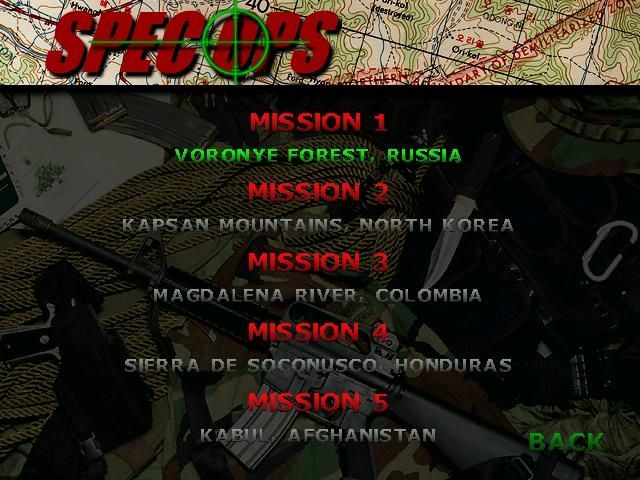Retro Replay Review
Gameplay
Spec Ops: Rangers Lead the Way drops you directly into the boots of an elite U.S. Army Ranger, tasking you with high-stakes missions that demand both precision and adaptability. The game’s real-time 3D third-person perspective, powered by the proprietary Viper engine, offers fluid camera controls and responsive character movement, making each firefight and stealth segment feel immediate and immersive. Whether you choose to clear a compound quietly or dive in with full force, the mechanics support a variety of tactical approaches.
(HEY YOU!! We hope you enjoy! We try not to run ads. So basically, this is a very expensive hobby running this site. Please consider joining us for updates, forums, and more. Network w/ us to make some cash or friends while retro gaming, and you can win some free retro games for posting. Okay, carry on 👍)
One of the most compelling aspects of gameplay is squad management. You don’t act alone—your success relies on coordinating with AI-controlled Rangers to execute flanking maneuvers, suppress enemy fire, and accomplish sub-tasks like defusing explosives or securing hostages. Issuing commands is straightforward, with a radial menu that pauses the action and lets you set waypoints, choose engagement stances, or initiate stealth takedowns. This level of control strikes a balance between micro-managing your team and staying in the thick of the action yourself.
Time constraints further heighten the tension of each mission. From the moment you receive your briefing to the countdown timer’s final seconds, you’re pushed to think on your feet. The game rewards efficient planning—scoping out patrol routes, stockpiling ammo, and selecting equipment before deployment—while penalizing hasty charges that leave teammates vulnerable. This blend of strategy and urgency ensures that no two playthroughs feel alike, encouraging players to refine their approach with each attempt.
Graphics
Built on the custom-designed Viper engine, Spec Ops showcases the ambition to push PC hardware of its era with detailed environments and dynamic lighting effects. From the sandy dunes of a Middle Eastern desert to the shadowy corridors of an abandoned warehouse, terrain textures are varied and richly detailed. You’ll notice the subtle grain of concrete walls, the rust on shipping containers, and the whir of helicopter blades casting moving shadows across the battlefield.
Character models are equally impressive for a late-1990s title. Your Ranger squadmates sport realistic gear—tactical vests, helmets, and weaponry that reflect their real-world counterparts. Enemy soldiers react dynamically to suppressive fire, taking cover, returning fire, or calling for reinforcements. While facial animation can appear stiff during close-ups, the overall presentation keeps you engaged, with dust particles and debris adding to the sense of chaos under fire.
One area where Spec Ops shines is its weather and time-of-day cycles. Missions can shift from blazing daylight assaults to dusk operations where long shadows and limited visibility make stealth all the more viable. Subtle effects like lens flares, muzzle flashes, and volumetric smoke reinforce the high-stakes atmosphere, even if some textures seem dated by today’s standards. For its time, the game stood as a graphical showcase for military shooters on PC.
Story
Spec Ops: Rangers Lead the Way opts for a mission-driven narrative rather than a traditional linear storyline. Each operation begins with a briefing that outlines your objectives—rescue downed pilots, sabotage enemy communications, or secure vital intelligence—and contextualizes the geopolitical stakes. Though there’s no central protagonist arc, the unfolding scenarios convey a sense of global conflict where every successful sortie inches you closer to victory.
The lack of cinematic cutscenes is offset by in-mission radio chatter and after-action debriefs. Your commanding officers relay updates, warn of patrol reinforcements, and celebrate hard-fought successes, all of which contribute to a believable command structure. These audio cues also serve as gameplay hints, alerting you to incoming threats or reminding you to complete sub-tasks before time runs out.
While the story framework is functional rather than emotive, it complements the game’s focus on realism. You won’t find over-the-top villains or soap-opera subplots; instead, the narrative stakes arise organically from mission goals and the ever-present risk to your team. For players seeking a grounded, authentic experience of modern warfare, this stripped-down approach enhances immersion rather than detracting from it.
Overall Experience
Spec Ops: Rangers Lead the Way offers a challenging blend of tactical planning and adrenaline-fueled combat that still holds appeal for fans of realistic shooters. The emphasis on squad-based coordination, timely decision-making, and mission variety sets it apart from run-and-gun contemporaries. Every firefight feels consequential, and the flexibility to choose stealth or full assault ensures that you can tailor the game to your preferred playstyle.
Despite its age, Spec Ops remains a noteworthy title for those interested in the evolution of military shooters. The Viper engine’s capabilities—dynamic lighting, varied environments, and responsive AI—laid the groundwork for more modern entries in the genre. While some mechanics, like the pre-mission loadout screen and waypoint-based commands, may feel dated compared to today’s UI standards, they capture the era’s design philosophy and contribute to the title’s unique charm.
For potential buyers, this game is best suited for players who appreciate methodical pacing over fast-paced action, and who don’t mind a steep learning curve. If you’re seeking a story-driven campaign with cinematic flair, you might find the narrative lean. However, if you crave authentic squad tactics, demanding missions, and the freedom to plan your approach, Spec Ops: Rangers Lead the Way remains a compelling choice that paved the path for subsequent realism-focused shooters.
 Retro Replay Retro Replay gaming reviews, news, emulation, geek stuff and more!
Retro Replay Retro Replay gaming reviews, news, emulation, geek stuff and more!









Reviews
There are no reviews yet.